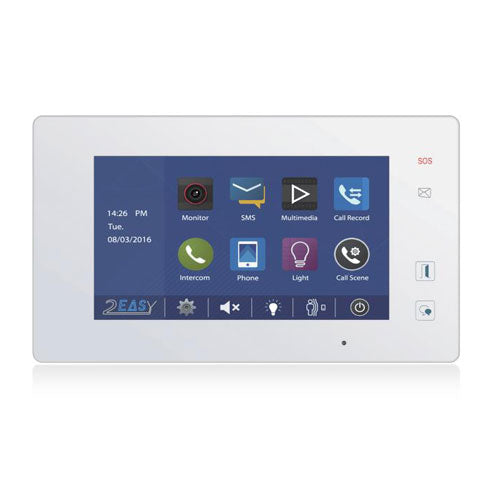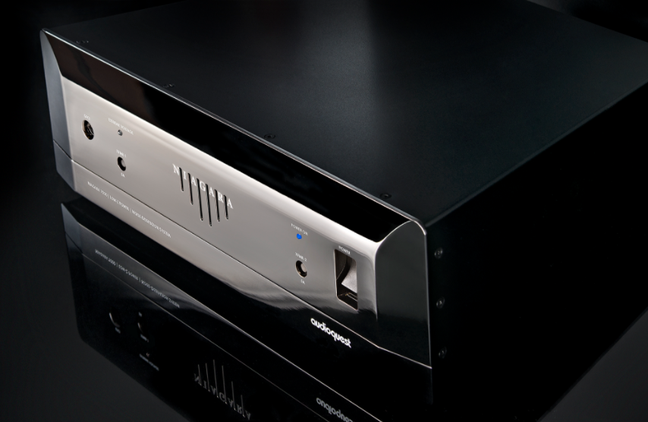The Wall Street Journal ran an article last August about Japanese audiophiles who have it all—and (gulp) still want more. Sound familiar? The reporter focused on audiophiles who are buying their own power poles and mounting their personal transformers on them. “Electricity is like blood,” one fellow explained to the newspaper. “If it is tainted the whole body will get sick. No matter how expensive the audio equipment is, it will be no good if the blood is bad.”
The image may be graphic, but he has a point. At bottom, your audio equipment is modulating electricity that’s sent to you from the power company. But what are you receiving? If you live in a city and are sharing a transformer with your immediate neighbors, then you’re more than likely the recipient of all the junk their computers, refrigerators, and so on are dumping back into the power line. There are different ways to address these problems—a few years ago, I had an electrician install a 375-pound Equitech 10 WQ balanced transformer that isolates my dedicated stereo lines from the rest of my house.
If by mistake I happen to plug one of my components into a regular house line, I immediately start to get hum emanating from the loudspeakers. Not everyone, however, wants to—or can—go to the length of messing around with heavy-duty transformers. Enter AudioQuest.
The company, which was founded in 1980 by Bill Low, has long been famous for its spiffy line of cables, and has recently begun to expand its reach. One move was to acquire distribution of the Lyra line of cartridges. Another has been to move into the power products, ranging from simple power strips all the way up to the $7995 Niagara 7000 Low-Z Power Noise-Dissipation System. The 81-pound Niagara 7000 is the brainchild of Garth Powell, the company’s director of power products. Powell has an extensive background in electronics and is also a professional jazz percussionist. About two years ago, AudioQuest hired him and essentially told him to design a new power device from scratch. With its deep pockets, AudioQuest could afford to bankroll Powell for a full year as he set about trying to devise a new approach. The truth is that Powell, who visited me to listen to the Niagara 7000 in my system, was like a kid in a candy shop. He can barely stop talking about the different challenges that electricity poses for stereo systems. He asserts, among other things, that up to a third of the audio signal can be masked by the crud riding on power lines. Given carte blanche by AudioQuest to design a new unit, Powell clearly went nuts on the design of the Niagara 7000, whose technology has trickled down into a variety of other, less expensive power products produced by the company.

One of the things that Powell likes to emphasize is that the Niagara 7000 is not a power conditioner. Instead, it relies on dielectric-biased AC isolation transformers to reduce distortion without reducing current to any component, including amplifiers—the Transient Power Correction feature is said to deliver up to a 90-amp current reservoir for power amplifiers. Essentially, the Niagara seeks to create a power bank for your amps so that it doesn’t have to strain to grab voltage from the wall. (The Niagara is complex enough that I don’t want to go overboard here on the technical aspects, but felt that the accompanying interview with Powell might be illuminating for readers who want to explore further.)
Alas, many of the conditioners that I’ve heard in the past may provide a more velvety background or tighter bass control, but a certain dynamic constriction seems, more often than not, to accompany these beneficial effects. The Niagara 7000 seeks to deliver it all. To that end, it features a bank of twelve outlets in the rear, with a set of four especially reserved for high-power devices. The plugs themselves are called NRG Edison AC outlets and, as AudioQuest warns, feature an extremely firm grip on the plug that mandates careful wiggling when inserting it into the unit. Flip on the engage switch in back, as well as a switch in front, and you’re off and running.
From the outset it was clear to me that the Niagara is an extraordinary piece of equipment that delivers numerous sonic improvements. Far from sagging in performance, the more components that I plugged into it, the better the Niagara sounded. Given the sheer number of components I use—Wilson Audio’s Hammer of Thor subwoofers dictates a second set of amps as well as two separate active crossovers—AudioQuest ultimately sent me a second Niagara for my power amplifiers. Once again, the sonic ante was upped. Throughout, the Niagara increases fine detail, expands the soundstage and improves the sense of black space. In some ways, listening to the Niagara really is like plunging over a waterfall—it carries you into a new sonic world.
The most immediate and salubrious effect of the Niagara was to offer a more controlled and refined performance. On Uncle Kracker’s memorable debut album Double Wide, for example, there was an enhanced sense of transient snap and accuracy, relaxation and mellifluousness, on songs such as “What’chu Lookin’ At” and “Follow Me.” The syllables of the epithets he employs as well as his more emollient croonings came through with a greater sense of precision.At the same time, the backing chorus was better separated from his solo lines.
This sense of precision was also vividly apparent on the Alabama Shakes’ imaginative album Sound & Color. On a variety of songs, the enhanced clarity that the Niagara supplied seemed to have the effect of subtly widening and deepening the soundstage. Once again, the bass lines were more starkly delineated, providing a better foundation for the vocals. Time seems to slightly slow down with the Niagara—lead singer Brittany Howard’s voice appeared to hover for a split-second longer in the air on “Gimme All Your Love.” Similarly, on the Christian McBride Trio’s CD Out Here, the Niagara delivered audibly tauter bass. Both McBride’s initial pluck and the decay of his bass appeared to be more elongated and controlled. What this all added up to was a more suave and sophisticated performance.
Did the Niagara shear off the treble to achieve these effects, as is the case with many conditioners? Not that I could discern. The treble is definitely smoother and rounder with the Niagara. On a Harmonia Mundi recording of the Freiburg Baroque Orchestra playing Bach’s violin concertos, I was smitten by the overall refinement of the sound of the violins as well as the deftness with which the Niagara helped placed the harpsichord in the context of the orchestra. On the violinist Hilary Hahn’s CD Encores, both her violin and the piano had a pleasing fullness without a trace of etch in the treble. What’s more, on other recordings, telltale instruments such as triangles didn’t appear to suffer any diminution in resolution or sparkle, near as I could tell.
There is no gainsaying, however, that the Niagara will enrich the sound. Whether you conclude that this is an artificial enhancement or an actual diminution in distortion is going to be a judgment call, which is why it’s best to demo a unit like the Niagara. In my view, the latter was emphatically the case. My only slight reservation about the Niagara centers on a different aspect—the unit itself can emit a buzzing sound. I have one friend in whose home it is dead silent, to the extent that he stuck a stethoscope on it and couldn’t hear any noise at all. But another acquaintance of mine, who couldn’t live without the Niagara, does experience some slight hum. I plugged my Niagara into both the house wiring and my Equitech-fed lines to see if there was any difference. There wasn’t. I don’t want to make too big a detail of this, but feel I would be remiss if I didn’t point it out.
Overall, the Niagara is a fabulous piece of equipment that adds sheen and palpability to the music that are utterly addictive. Once you’ve heard the Niagara, it may be impossible to go back.
Specs & Pricing
Type: AC power device
Outlets: 12 (four of them high-current)
Dimensions: 17.5" x 5.24" x 17.2"
Weight: 81 lbs.
Manufacturer Comment
We greatly appreciate the time Jacob Heilbrunn spent evaluating the Niagara 7000, as well as his ability to effectively communicate his experience with TAS readers. The very slight mechanical hum that Mr. Heilbrunn sometimes experienced has to do with the quantity of harmonic distortion on the utility line. The Niagara 7000 is doing its job and is converting this line distortion into heat via magnetostriction, which manifests as the very low level mechanical hum that Jacob refers to. Even electrical panel isolation transformers, though potentially beneficial, will not reduce that type of distortion. Thus far, an exceedingly small percentage of users—approximately 1% — have experienced this. Most importantly, Mr. Heilbrunn enjoyed a wide variety of music with an enhanced clarity and solid musical foundation that he found enriching.
Bill Low, Joe Harley, Garth Powell, AudioQuest
Link to the review:
http://www.theabsolutesound.com/articles/audioquest-niagara-7000-low-z-power-noise-dissipation-system/?page=2


